
Earth
Explainer: Sprites, jets, ELVES and other storm-powered lights
Fleeting glows collectively known as “transient luminous events” flash in the skies above powerful lightning storms.
Come explore with us!

Fleeting glows collectively known as “transient luminous events” flash in the skies above powerful lightning storms.

This dangerous trend appears relatively new — and growing. Studies also have begun linking it to our warming world.

The eruption plume spawned lightning that started 20 to 30 kilometers (some 12 to 19 miles) above sea level.

These long-traveling storm systems bring moisture to many parts of the world. Here’s what scientists are learning about them.

Lake Mercer may serve as a model for better understanding the birth and life of Antarctica’s hundreds of subglacial lakes.

A new study finds they can leak benzene and other harmful chemicals into homes, sometimes at very high levels.

Inland melting of the Northeast Greenland Ice Stream is accelerating — and may contribute far more to sea level rise than earlier estimates suggested.

This is bad news as a warming planet leads to growing numbers of excessive heat waves — and millions more people facing potentially deadly temperatures.

It appears the Pine Island and “Doomsday” Thwaites glaciers are losing ice — and shrinking faster — than at any time in the past 5,500 years.

An atmosphere is an envelope of gas around a planet, dwarf planet or moon.